Some days ago Fudo played with the Acer Aspire Revo and checking the playback of Blu-Ray DVDs with an external Blu-Ray Player which did not disappoint. Today we will take a closer look at the general performance.
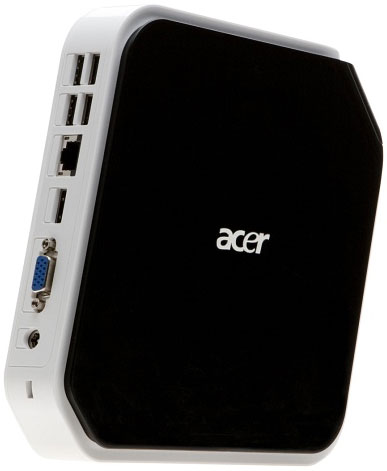
Acer Revo comes with single core Atom 230, 2GB DDR2 memory and 160GB hard drive and since we're a hardware oriented site, it's only natural that we take a look inside that box and show our audience what the Revo is made of:
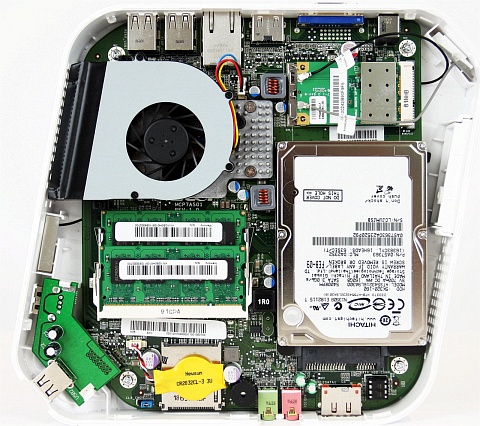
Click here for a bigger picture.
As you can see, it's nothing like your ordinary ITX or µATX board, it's more a notebook PCB with all parts packed together. The most annoying thing about the Revo is its small fan, top left. It is noisy even when running at only 2000rpm. While the Revo is nowhere as thin as a netbook, there is plenty of space to install a bigger fan which would rotate at a lower rate. Also, a heatpipe-solution, perhaps even a passive one, would be possible.
You may remember us praising all the boards which come with integrated MOSFETs, integrated chokes and solid state capacitors. Unfortunately on this board you'll find none of that, so our guess is that Acer did everything to reduce costs. If you remove the cooling solution, first the fan, second the aluminum heatspreader the two chips driving the Revo are revealed:
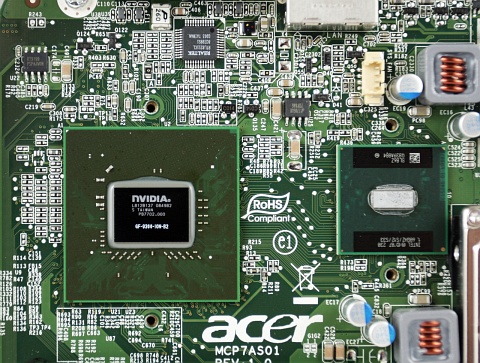
Click here for a bigger picture.
The GeForce 9300 is a downgraded GeForce 9400 which is used in many notebooks, most notably inside Apple's latest MacBooks. Nvidia nowadays calls this simply Ion and leaves Geforce 9300 or MCP79 names for the other markets. The Atom processor is very disappointing, because it's only a single-core which is still slow, especially with Vista installed. Fortunately, the BIOS does allow for a limited overclocking, so we can squeeze out 2GHz instead of 1.6GHz. Single core doesn't really like normal multitasking even when Hyperthreading is supported as it doesn't pack enough horsepower to deal with it. Dual core Atom 330 would definitely be a better albeit a slightly hotter choice.
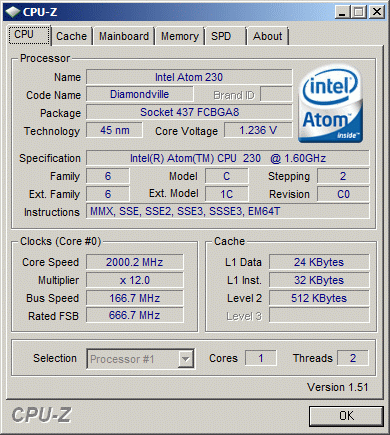
GPU-Z has some troubles showing all the data. Of course the chip does not use any dedicated memory, but borrows 256MB from the main-memory in auto-configuration. The BIOS allows to set values of 32MB, 64MB, 128MB, 256MB and 512MB. We left the setting on auto, but even 128MB would be sufficient for running Aero on Windows Vista.
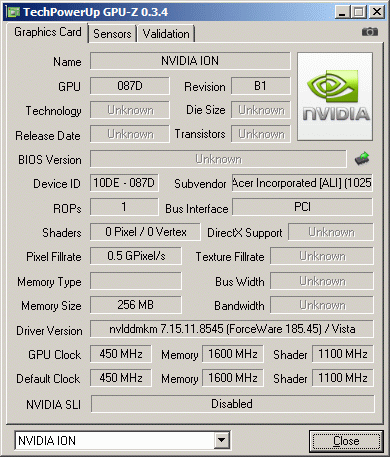
No news about benchmarking. The Atom is still a crippled P4 which means the CPU is slow as hell, especially compared to Intel's high-end offerings. But besides that, the chipset helped with Aero, so disabling all the effects besides "Crystal Clear" does not make much of a difference. Surprisingly Vista was not completely stalling, but opening a website does take considerable time. Especially annoying was the updating, 17 updates took 1h 32minutes to download and install but this is what you get with Vista. Still you get enough performance for basic tasks like browsing, even basic gaming, something that Intel cannot do at all with nettop platforms and especially you get some nice multimedia expirience.
The Atom still is the slowest CPU with LameMT.
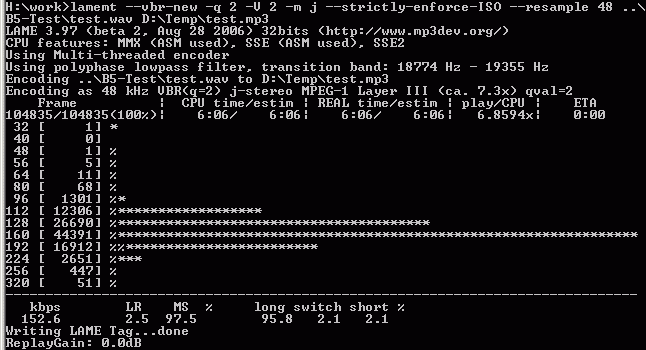
Just for the fun of it, we ran 3Dmark03 and 3DMark06. While the first did produce all the benches without stutter, the later was a pain to watch, so don't consider this platform for serious games but some basic ones at low resolutions should be ok.
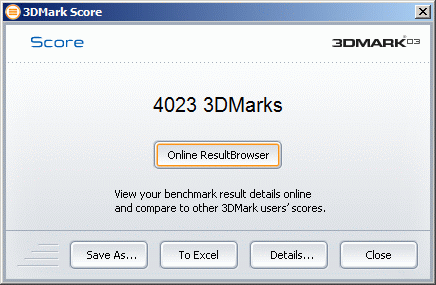
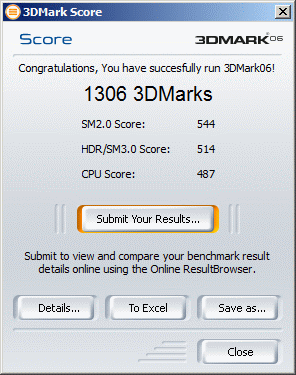
While Fudo proved Blu-Ray was not a problem at all, we though it would be nice to test if this is the case with files. As already proved a XVID or DIVX encoded movie in DVD quality is not even a problem for any Atom CPU.
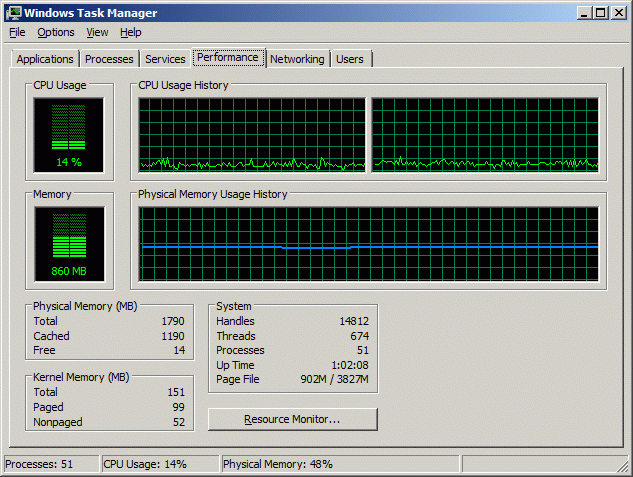
At 720p resolution the CPU load did not change.
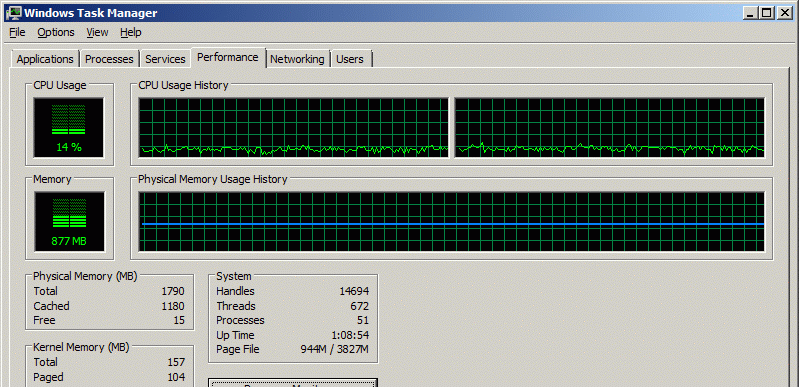
Surprisingly even 1080p did not impress the Ion at all.
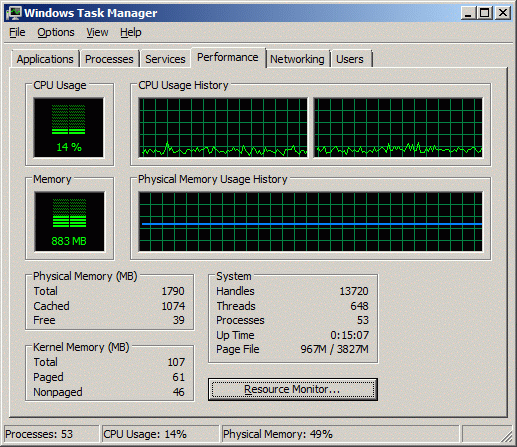
All the tests were done with ffdshow and Media Player Classic Homecinema Edition. As long as you enable EVR output which is unique to Vista and Windows 7 all runs smoothly. If you change to DX9 renderless output the CPU load increases heavily, but 720p is still playable.
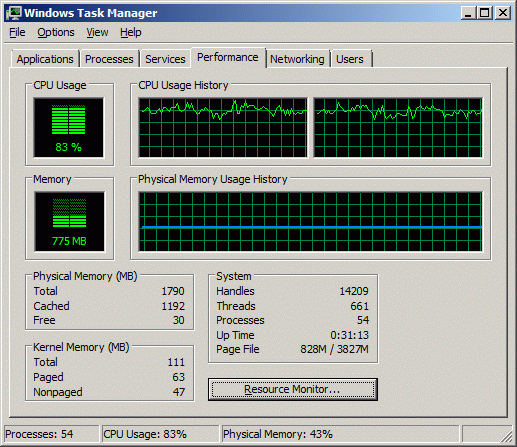
Power-Consumption:
In our previous Atom reviews we were not too fond of the power-consumption because the Atom is paired up with the horrid 945GC chipset, which Intel probably found in some hidden dungeons below its HQ. The "Ion" however does paint a different picture. The CPU of course is still slow, but the chipset did help and even ran Vista at an acceptable pace, so we hope Windows 7 will improve on that. It manages to get under the 20W mark in idle mode, but we had troubles to push the system over 25W so the reason behind Acer's decision to ship this system with a 65W external power-supply is a riddle we won't even try to solve.
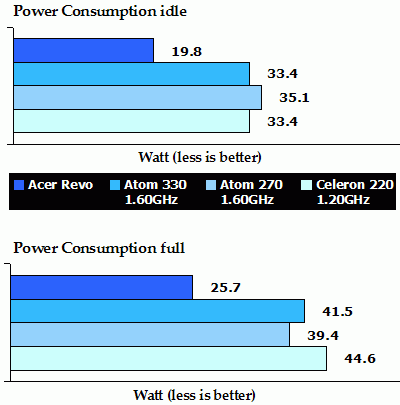
Conclusion:
The idea behind the Revo is a good one, but the execution lacks. First of all, there are some design problems, especially with the GbLAN connector. Not everyone owns a TFT with HDMI input, so they will be forced to use a HDMI to DVI dongle. If this is just a dongle and not a cable, you can barely fit the network cable into the socket. A system which consumes only about 25W does not need active cooling when fitted in such a big case. Even with active cooling they should think about a bigger fan which will generate less noise.
As this gadget sells for €299,- in Germany and Austria while in France you can buy it for less than €250. Acer launches it systems strategically and it picks the region launch time and pricing based on its own formula. Compared to Asus' Eee Box or MSI's Wind, the price is competitive, because Acer Revo offers basic gaming and good multimedia and in this fight it clearly wins over Intel's nettop platform.
The trouble is that for the same price you get a netbook, and for €100,- more a decent notebook with a "real" CPU. This is not a machine meant for this market but this is just a thought. This machine is also too slow to replace a desktop. For your everyday work you can't be expected to wait 20 seconds until IE kindly opens a new tab for you.
Yes, you can install XP which will work faster, but then you mayl loose the HD decoding possibilities of the chipset when the driver does not support EVR (Enhanced Video Rendering). Due to time pressure we could not install XP to test it. For less than 1/3 of the price you can also buy tons of multimedia players such as the WD Digital Media Player which comes with more outputs and doesn't need any Windows OS. Note that Windows 7 will run nicely on this machine and you should be able to improve your experience due to DX support inside the Ion chip.
Nvidia's Ion definitely makes a difference and improves the nettop platform significantly. We would rather say it gets Atom nettop "desktop" platform to the next level as it can play 1080p video flawlessly, and it can let you play Call of Duty 4 at some basic resolutions. Additionally, this machine can also accelerate CUDA applications, which would probably speed up your video conversion and a few other operations as well. This should be enough for most consumers, but if only Acer used a dual-core Atom, it would have ended up with a fierce competitor and a sure winner on its hands.
Print this page


Review: 25W system plays 1080p
Published in
Reviews
Acer Aspire Revo dissected

Review: 25W system plays 1080p
